
© Sergei Andreetsev. (Click image for larger version)
Dance Open Festival Gala
St. Petersburg, Alexandrinsky Theatre
28 April 2014
www.danceopen.com
Soul of Dance Ballet Gala (Dusha Tanssi)
Moscow, Stanislavsky and Nemirovich-Danchenko Musical Theatre,
30 April 2014
stanmus.com
Two Russian Galas
Gala concerts can be long-winded and boring events with the same repertoire produced time after time – pas de deux from Don Quixote, Giselle, Le Corsaire, Coppelia. However, two recent events in Russia’s main cities were very different – not just in dance content but also in their approaches.
Dance Open’s gala in St. Petersburg, now in its 13th year, invites top dancers from international companies to perform and compete for one of the crystal figurines of Pavlova’s foot. The categories range from Mr/Ms Virtuosity to Expressivity and there is a People’s Choice award.

© Stas Levshin. (Click image for larger version)
In Moscow two days later the Soul of Dance Ballet Gala, was held. Organized by the Russian dance magazine ‘Balyet’ for the past twenty years, it honours not only dancers, but also other notables in the dance world who have contributed to the success of dance in general. These are teachers, coaches, critics, stage managers, photographers and sponsors.
Dance Open’s 2014 celebration in St. Petersburg was part of the five-day event which was again very well organized by the team of Ekaterina Galanova, Vasily Medvedev and Olga Belenkis who invited three contemporary companies to perform on the first four nights: Complexions (USA), Malandain Ballet Biarritz (France) and Dutch National Ballet. On the final evening, the stage came alight with a fine array of dancers from the Bolshoi Ballet, Mariinsky Ballet, American Ballet Theatre, Royal Ballet, English National Ballet, Norwegian Ballet, Staatsballet Berlin, Hamburg Ballet and the Stanislavsky Ballet. They danced their party pieces in front of jury members, which included Hans van Manen, Ted Brandsen, Vladimir Malakhov, Manuel Legris, Galina Stepanyenko, Yuri Fateev and Boris Eifman, and an excited St Petersburg audience.
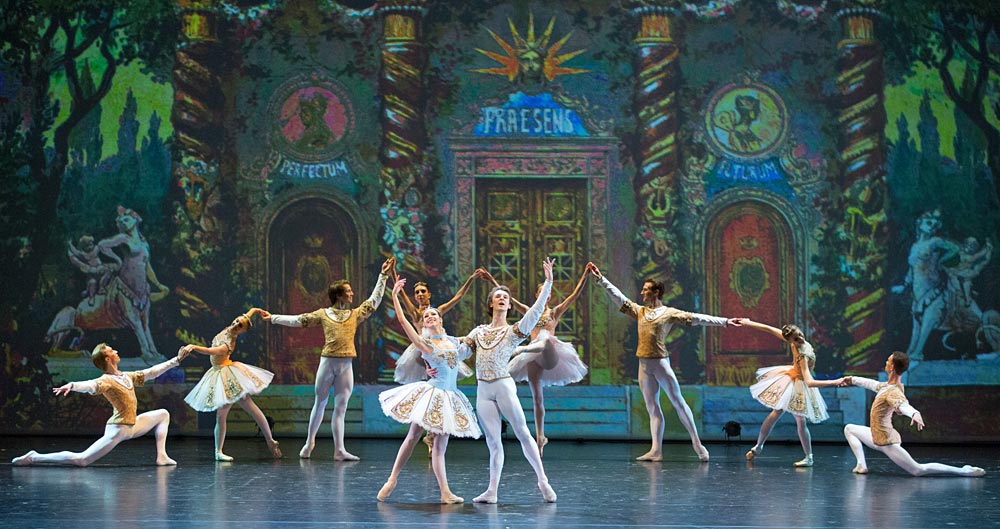
© Stas Levshin. (Click image for larger version)
The highlight of this gala however came as the final piece and was in sharp contrast to all the twenty-first century fireworks seen on stage earlier in the evening. The artistic director of the festival, Vasily Medvedev has meticulously researched and reconstructed the Grand Pas from Marius Petipa’s ballet Bluebeard, staged in 1896 (music: Peter Schenk) but lost soon after. Medvedev pored over the score, old photos and papers to re-stage this twenty-minute gem from the ballet – a divertissement that could be taken on its own merit into any company’s repertoire. It’s a party piece that is charming and old fashioned, demonstrating the finest of Russian classical ballet. There are four couples in gold outfits and decorated tutus who perform a gentle dance in anticipation of the leading couple, neatly performed by dancers from the Yakobson St Petersburg Ballet Theatre. The pas de deux is elegant and pure, and was performed beautifully at the gala by the Bolshoi’s Kristina Kretova and Semyon Chudin, who picked up Mr and Ms Virtuosity prizes. Thanks to Medvedev, we had a glimpse into the past and a view of a once-thought-dead ballet that, even today with all the pyrotechnical performing on show, proves that purity and elegance still make their mark in the classical ballet world.

© Stas Levshin. (Click image for larger version)
In sharp contrast and demonstrating the development the today’s popular technique were Royal Ballet’s Melissa Hamilton and Eric Underwood. They danced a duet from Wayne McGregor’s Raven Girl, which had even the seasoned dancers backstage drawing breath, amazed by the dangerous series of lifts.

© Stas Levshin. (Click image for larger version)
Further excitement was on offer from Iana Salenko and Joseph Gatti who, though they only met up the day before, presented an excellent artistic and drama-filled pas de deux from Le Corsaire. Gatti had mischief in his eyes as he bored holes in the floor with his turns and leaped and twisted mid-air. Salenko was not to be outdone, albeit with lady-like triumph. She was so relaxed and content on stage that her dancing just glowed, and appeared easy and natural. The pair won the Best Duet prize – yet another glass slipper for each, as they have won in past Festivals.

© Stas Levshin. (Click image for larger version)
English National Ballet was well represented. Zdenek Konvalina danced an excerpt from Bejart’s Greek Dances proudly and with style, while Daria Klimentova and Arionel Vargas swooped and swooned in Derek Deane’s Summertime. A few of the Bad Boys, with Adrienne Canterns (the company is coming to Sadler’s Wells Theatre in June), amazed with their tricks and tumblings in Rock You. The Diana and Acteon pas de deux was danced with panache by Cubans Yolanda Correa and Yoel Careño, now with Norwegian Ballet. While Yolanda tossed off fancy fouettés, with (some say) a 9 pirouettes finish (I stopped counting at 6!), Yoel was his handsome self, throwing himself in the air with such force that he seemed to be flying. And when he touched down, he hurtled off at breakneck speed – all done in great classical style and with musicality, I hasten to add. Misty Copeland (ABT) danced Marcelo Gomes Paganini, Anna Tsygankova (DNB) danced Jose Martinez’ Delibes Suite with Matthew Golding – she received the Dance Open Grand Prix. Remi Wortmeyer (DNB) danced his own jolly solo Joel with great vivacity and good cheer, and shared the People’s Choice prize with Careño; and the Bubenicek twins, Otto and Jiri , with Jon Vallejo, performed a powerful but pleasing trio of great male dancing.
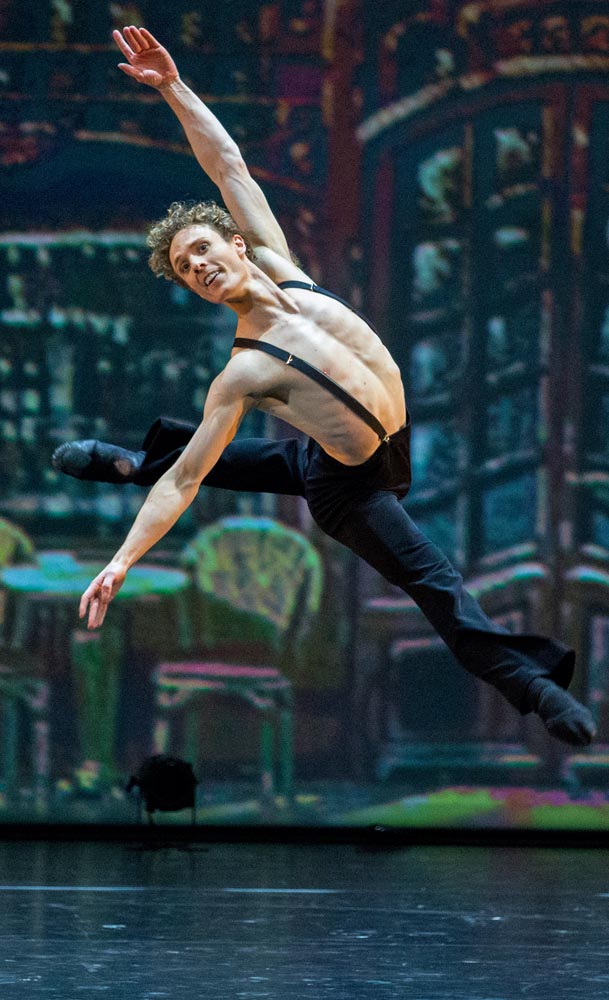
© Stas Levshin. (Click image for larger version)
After an explosive shower of golden tinsel on all the dancers at the final curtain, the evening moved to the beautiful Marble Hall of the Russian Museum of Ethnography where prizes were handed out and everyone hung out around a good buffet until the early hours. Well mostly everyone – I had to be packed and up by 5am to catch the train down to Moscow for the next gala!

© Sergei Andreetsev. (Click image for larger version)
The Soul of Dance Ballet Gala in Moscow two days later – it’s hailed by some as ‘the ballet world’s Oscars’, was held at the Stanislavsky Theatre and opened with the company in the ‘Shades’ scene from La Bayadere. The ramp down which 32 ballerinas gracefully and evenly traversed was set beneath a full moon and between blossom trees, which, being painted on the back drop, shimmered with the magical movement as the dancers passed. The Shades’ lines were straight, the challenging balances well controlled, and legs were all at an even height. The ballerina, Natalia Somova, moved smoothly and pleasingly with careful unfolding arabesques and stretched jetes, and her pique turns were like quicksilver. However, there was little connection between her and her Solor –here in the person of Sergei Polunin (who hadn’t turned up in St Petersburg to dance Les Bourgeois as expected). He excelled in high leaps and spectacular jetés and jumps and looked very handsome, but there was no life in his eyes. Perhaps he was taking the role seriously – a drug induced hero who dreams this fantasy. But for a gala, there should have been a bit more excitement, especially since he and his partner were to receive the first awards of the evening, presented to them by Boris Akimov and (the three days married), Evgenia Obratsova.
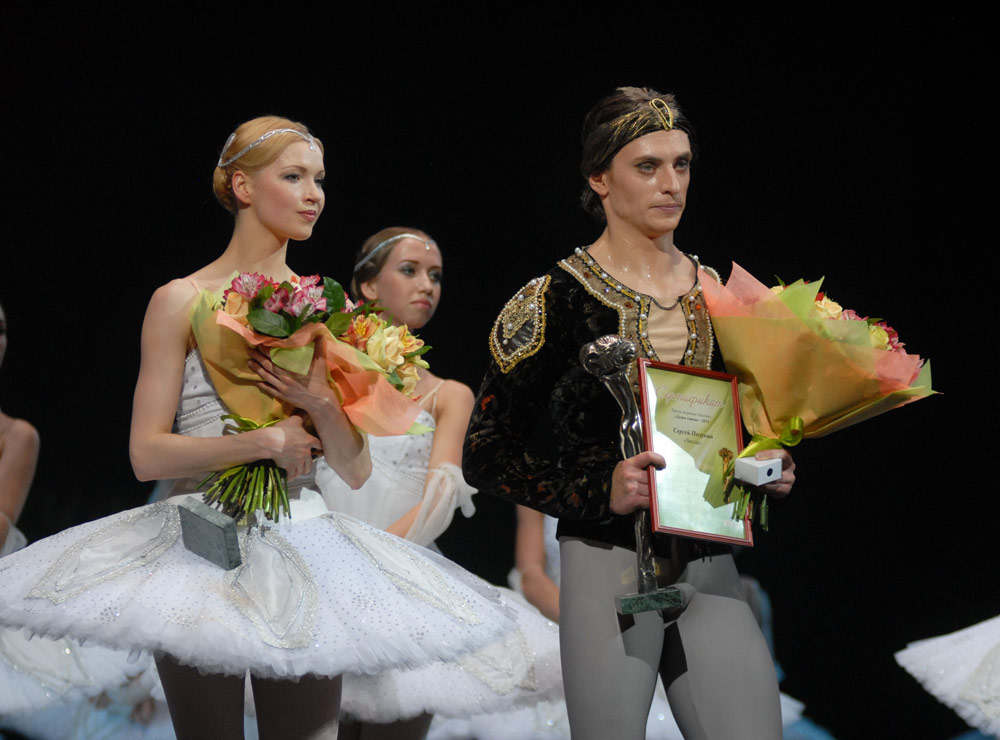
© Igor Zakharkin. (Click image for larger version)
The Bolshoi’s Olga Smirnova then picked up an award on behalf of Natalia Makarova for her contribution to ballet, and was followed by the youngest students from the Moscow State Academy of Choreography charmingly performing Suvoretsi – the boys in military uniform, the girls in pretty dresses. The next prize was for a teacher of 58 years at the Moscow Ballet Academy – Ina Varonina.
The MC for the evening was Gennadi Yanin, the former manager of the Bolshoi Ballet, and he made a cheerful and chatty host, keeping the action of dance and prizes moving along well. The seasoned critic, Igor Stupnikov from St Petersburg, received an award, as did photographer Vladimir Lunovskoi. Among the sponsors, Nikolai Grishko was given an award for his tremendous financial support of this – and also the Dance Open – event. Mariinsky dancer Andrei Ermakov was another recipient, and he and Oksana Skorik performed the Corsaire pas de deux, sadly with little excitement, though she always looked relieved whenever she completed anything tricky.
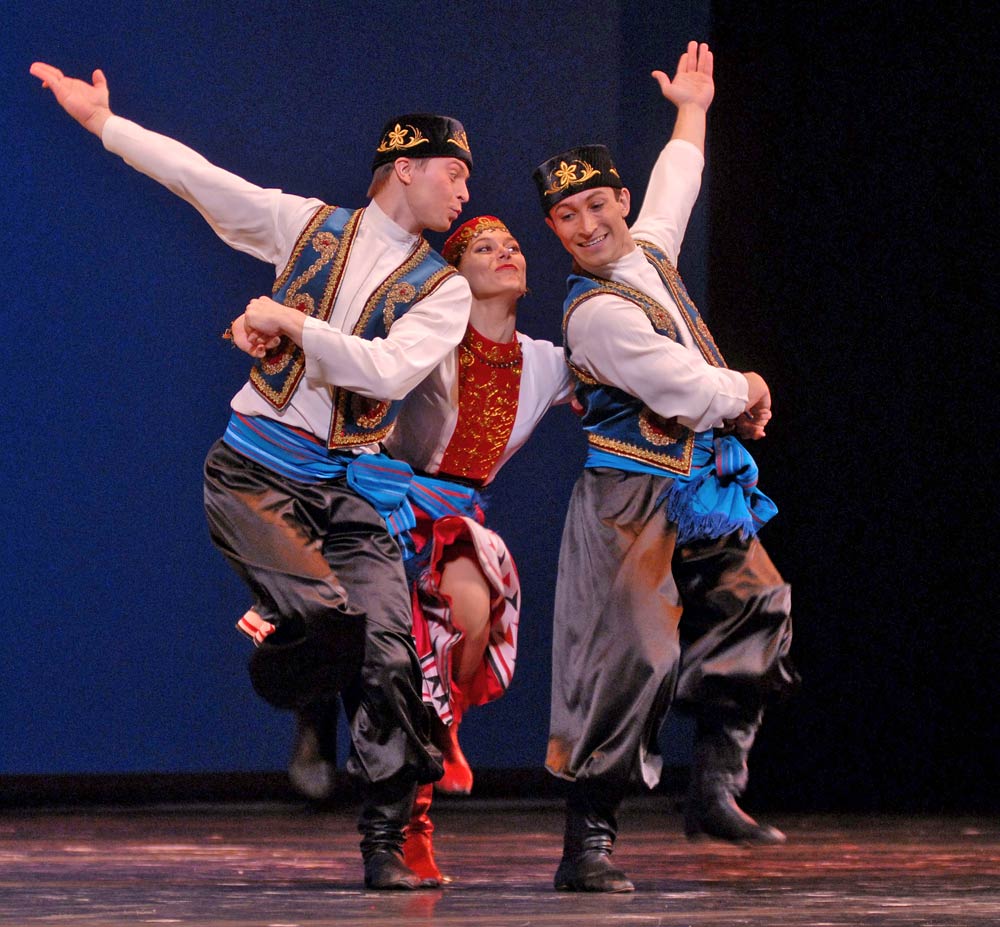
© Igor Zakharkin. (Click image for larger version)
Dancers from the Moiseyev Folkdance Company livened up the stage in two fast-paced exacting pieces – their smiling faces and delight making the audience happy too. The new Vaganova School director, Nikolai Tsiskaridze, was in the audience to watch his former pupil, Angelina Vorontsova, now with the Mikhailovsky Ballet, dance a delicate Talisman pas de deux with the talented Denis Rodkin of the Bolshoi – both of them picking up awards for their performing this past year.

© Igor Zakharkin. (Click image for larger version)
The second half saw dancers from Tatar Opera and Ballet Theatre in a cheery Harlequinade, a couple from Perm perform a Dying Swan duet by Alexei Miroshinchenko and Oleg Gabishev, who has just been in London with Eifman Ballet, danced his own work, Macho with all the vigour he showed in Rodin. He was presented with his award by Marina Kondratieva for all the ballets he dances.
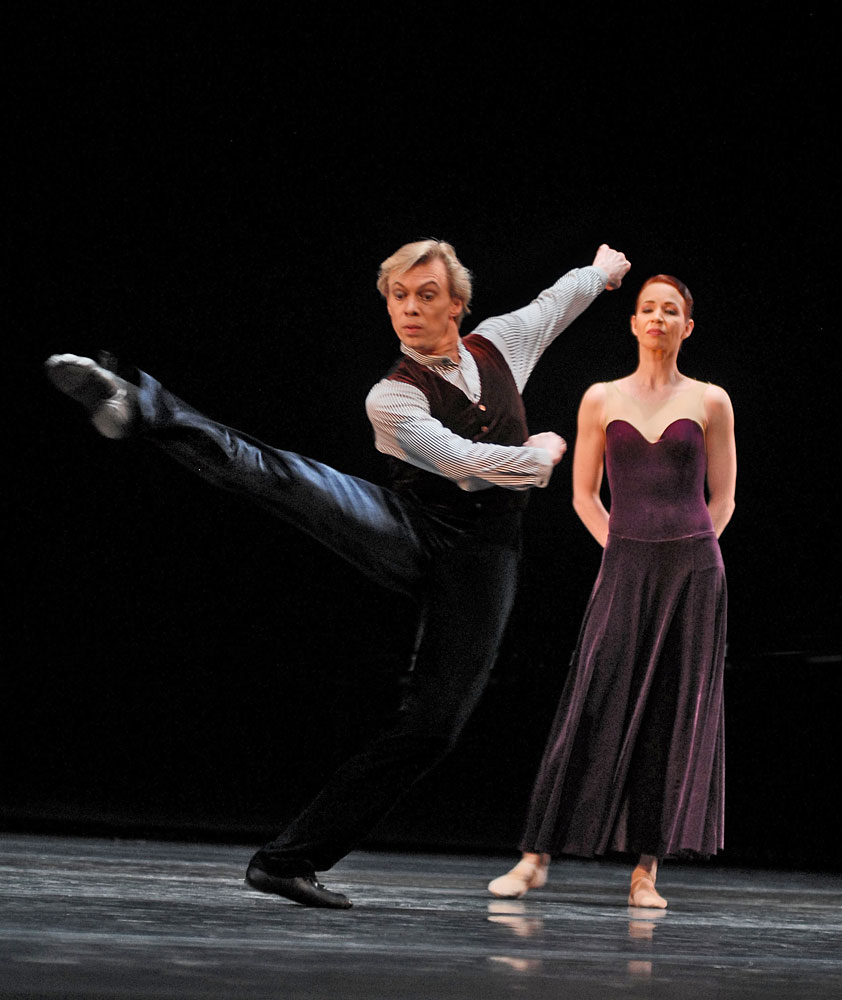
© Igor Zakharkin. (Click image for larger version)
The highlight, and finale, of the evening was Hans van Manen’s The Old Man and Me, performed by Vladimir Malakhov and Beatrice Knopp of Staatsballet Berlin. Malakhov, who is about to take up directorship of Tokyo Ballet, is a very popular figure in his ballet hometown of Moscow and looked anything but old. He basically did very little movement to begin with other than watch a slinky Knopp trying to seduce him. But their timings were spot-on and there was much humour in the piece, which kept the attention well – the audience loved it. A veritable Peter Pan of ballet, youthful-looking and still performing well, Malakhov received a special prize for his twenty-eight years of excellent dancing both at home and abroad, where, by demonstrating high standards and technical bravura, he has held the flame of Russian ballet alive around the globe.

© Igor Zakharkin. (Click image for larger version)












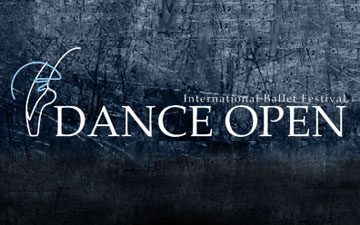
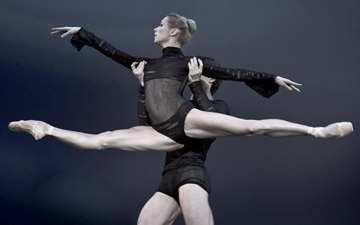


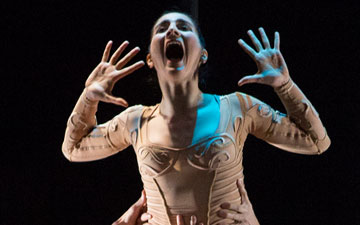
You must be logged in to post a comment.